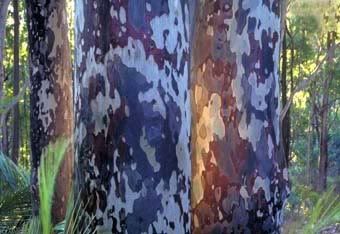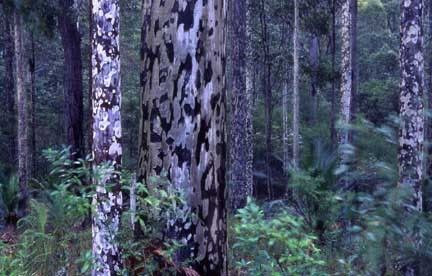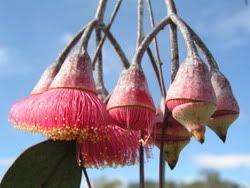. "Spotted gum" can refer to four different species of Corymbia.
The ones in the pic are Corymbia maculata, previously known as Eucalyptus maculata. They are very beautiful and can have trunks ranging in colour from green, brown, pink, white, grey, bluish grey and it seems, nearly everything in between. they deciduate their bark in patches in late spring and summer.
Here's another pic
New foliage
You can tell I'm a fan.
Some can be poisonous at various times of year.
Koalas eat exclusively eucalyptus foliage and often eat psychoactive varieties and sit around stoned out of their tiny minds all day.
They do indeed smell like a cough lollie and when you're walking through the bush and smell the telltale dung, just look up and sure enough there will be one.
The smell of Eucalypt forest has to be experienced to be believed, after rain or on a hot still day the air is completely heady and it's not hard to be feeling a little high on the scent alone. They are highly combustible and live or dead they are still full of oil and burn like crazy. A Eucalypt forest on fire, especially fanned by strong hot winds is a very scary thing. Experienced firefighters still die regularly despite protocols and precautions. Many people tell of the repeated explosions as whole trees ignite in a second.
The variety of Eucalypts is stunning. Their beauty is outstanding ( sometimes it takes years to appreciate, many new arrivals to Australia find them rangy, scraggly and dry looking), there are stark white trunked species growing in the searing outback set against deep blue skies and red rocks, gnarled, twisted multicoloured trunked snowgums in the high country, rainforest giants, ones which smell of citrus, peppermint, massive river redgums which tolerate droughts or years of inundation. Species with silvery grey foliage, species with massed blooms of red, pink or white, diverse and intriguing seed pods. I could go on.
They are a study unto themselves











